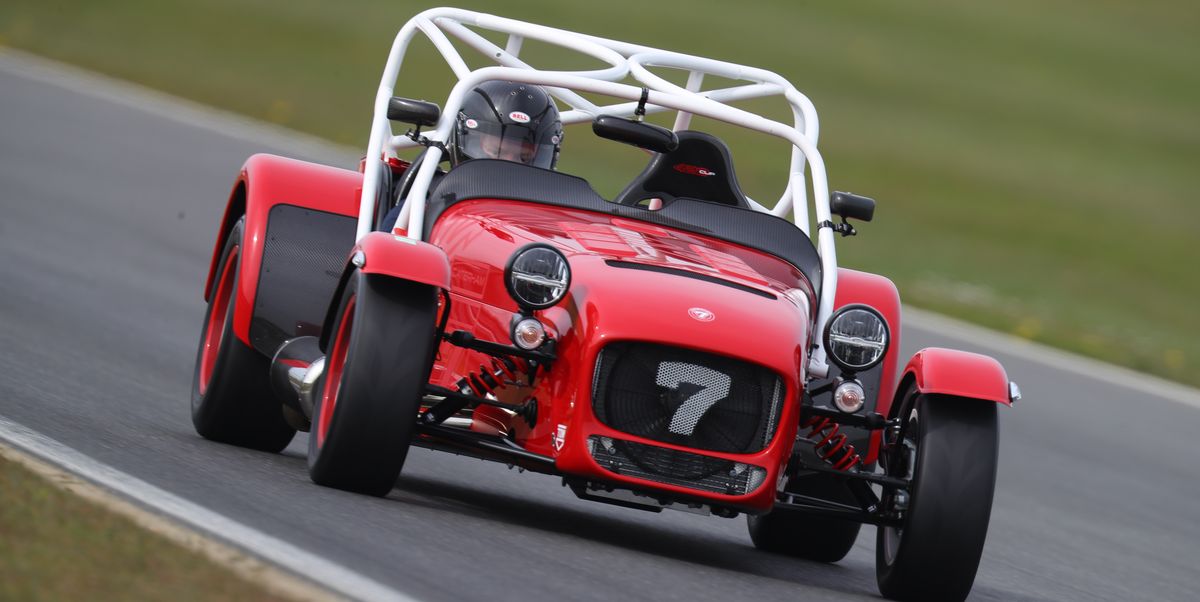2022 Caterham Seven 420 Cup: Elemental Speed

Although Lotus is launching its final gas-powered car in the form of the new Emira, the British sports-car maker’s first model, the Seven, is still going strong after Lotus founder Colin Chapman sold the car’s manufacturing rights to Caterham in 1973. Now 49 years later, in heavily evolved form, the Caterham Seven continues to offer an experience that is pretty much that of a four-wheeled motorcycle.
While sales in the United States have dwindled to only about 30 cars a year—against a total production of around 650—Caterham’s U.S. fans are enthusiastic enough for the company to export its new 420 Cup model, which we got to experience on the 2.9-mile track at Snetterton in Norfolk, England. It is an appropriate setting as Lotus’s current Hethel HQ is just 15 miles away, but also because the 420 Cup is intended primarily for track use, despite being street legal in Europe. As with previous tests of a Caterham, we can confirm that they are great fun as long as the weather is warm and dry, but categorically not when it turns cold or wet.
The 420 Cup has more in common with the brand’s race cars than its road-going counterparts. It uses a dry-sump 2.0-liter Ford Duratec four-cylinder, which revs to 7600 rpm without complaint as it churns out 210 horsepower and 150 pound-feet of torque. That relatively modest state of tune is intended to strengthen the engine’s longevity and reduce running costs. Power is sent through a standard six-speed sequential transmission made by SADEV, which is operated by a substantial push-pull lever in the center of the cockpit rather than steering-wheel-mounted paddles. It also retains a clutch pedal, though this is mostly only used for starting, downshifting, and slow-speed maneuvering. Power reaches the rear wheels via a mechanical limited-slip differential, and the 420 Cup sits on Bilstein dampers that can be adjusted through 10 steps of stiffness by easy-to-locate click rings. Rolling stock consists of 13-inch track-biased Avon ZZR tires.
Caterham builds two versions of the 420 Cup. The first we sample is the wider, longer, and slightly heavier SV version—known by many of Caterham’s British fans as the “fat boy,” as its chassis has been expanded to help accommodate occupants larger than the malnourished jockeys the original Lotus Seven was seemingly designed for. Ticking the SV box widens the Caterham by 4.3 inches, increases length by 9.9 inches, and adds 55 pounds of mass, but it does give more leg- and elbow room. Still, having to climb through the roll cage to gain access brings a jungle-gym workout to the start of any drive.
The cockpit is predictably short of fripperies, with much of the switchgear being old-fashioned toggles laid out in the center of the carbon-fiber dashboard. Caterham has been using these for so long that they seem to have become fashionable again. Instrumentation is by equally traditional dials, though the SV’s diminutive dimensions mean there isn’t enough space to position these in front of the driver, so the fuel, temperature, and oil-pressure gauges are offset in front of the passenger.
The Ford four-banger exhales through a rorty exhaust and revs enthusiastically at the slightest prod, but it’s tractable enough to get the car rolling easily down Snetterton’s pit lane. Even in chunkier SV form, Caterham’s claimed curb weight of just 1290 pounds makes the 420 Cup one of the lightest four-wheeled vehicles on the planet. Yet the madness of today’s relatively stratospheric power outputs means that its raw acceleration doesn’t feel exceptional; its claimed 3.6-second 60-mph time is slower than some of those delivered by modern high-performance SUVs. But if powerful, heavy cars are sledgehammers, the Seven is a scalpel. Just on our out lap the car proved to have huge grip and a willingness to change direction that comes from not having very much mass to turn. The steering feels closer to that of a kart than a conventional car: slack-free and instant in response. The Cup is also able to make what feels like daringly late braking points seem cautiously early.
There are few cars that are this quick yet so easy to push to their limits, especially without any kind of electronic safeguard. It’s a joy to play with the varying amounts of adhesion generated by each of the Caterham’s axles, with the differential at the back helping the 420 Cup to progressively tighten its cornering line under power—or to be pushed into modest oversteer without losing pace. The sequential gearbox will upshift with the accelerator floored, and the shift lights on the dash encourage the full use of the available rev range.
This not to say that the 420 Cup is entirely foolproof. The brakes’ lack of anti-lock hardware became apparent when, emboldened by the sheer level of available deceleration, we tried to brake too late for a corner and locked up the front wheels. Similarly, the need to use the clutch while downshifting the sequential gearbox took getting used to and resulted in some chirps of protest from the rear tires. Yet we doubt any other car could make 210 horses feel more exciting.
Swapping to the regular-size 420 Cup brings a predictably tighter-fitting cabin. While the reduction in width and weight don’t dramatically transform the driving experience, they do make the car feel wieldier and more willing to turn into tighter corners. We also had the chance to experience how easily the chassis settings can be adjusted and the effect this has on the driving experience. The regular-size car was initially sent out with its dampers set firm and then later pitted for these to be softened through the click-wheel adjusters. This resulted in the Cup losing a noticeable amount of front-end bite, yet its rear gained an amusingly progressive tendency to break away under power.
The 420 Cup will reach the U.S. later this year for use only on the track, an environment it is obviously best suited for. Although pricing has yet to be finalized we can report that in Britain it costs slightly more than the 620 model, which starts at the equivalent of about $65,000. The Seven has lived longer as a Caterham than it did as a Lotus, and almost all of its steady evolution of performance has come from its second parent. The 420 Cup is a very different beast than the 1957 original, a car that featured a live rear axle and was powered by a 40-hp Ford side-valve engine. Yet the same spirit still connects the two ends of this long-lived and wonderfully minimalist sports car.
A car-lover’s community for ultimate access & unrivaled experiences. JOIN NOW
This content is created and maintained by a third party, and imported onto this page to help users provide their email addresses. You may be able to find more information about this and similar content at piano.io




